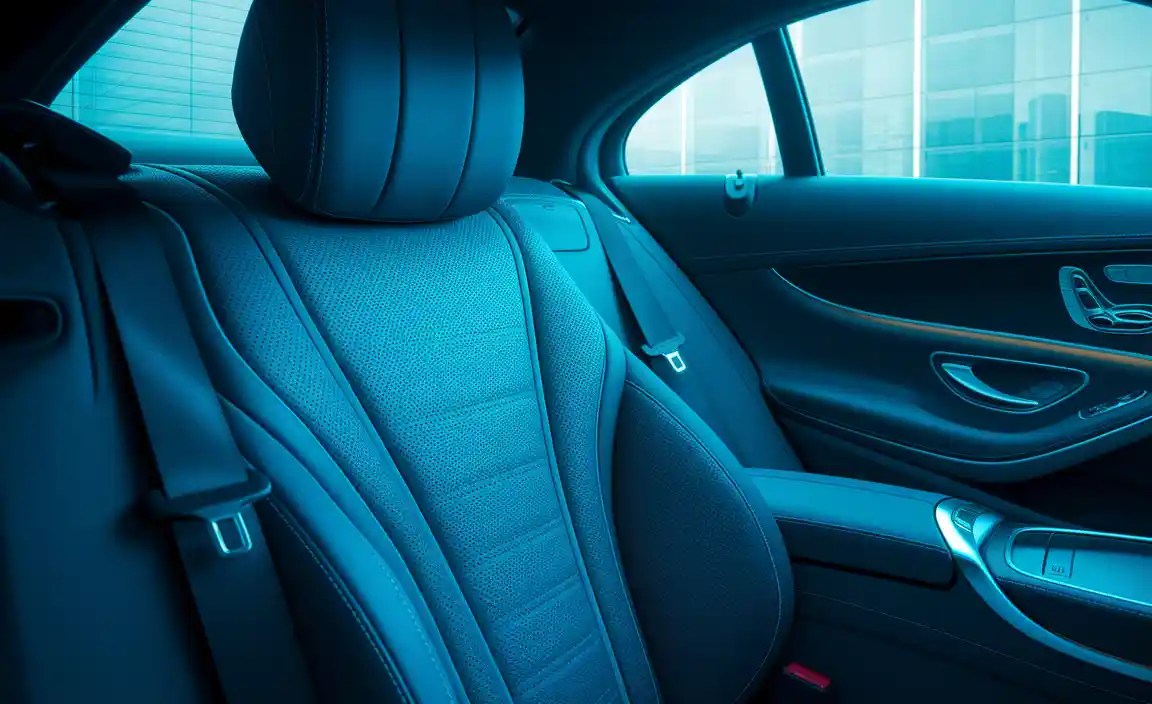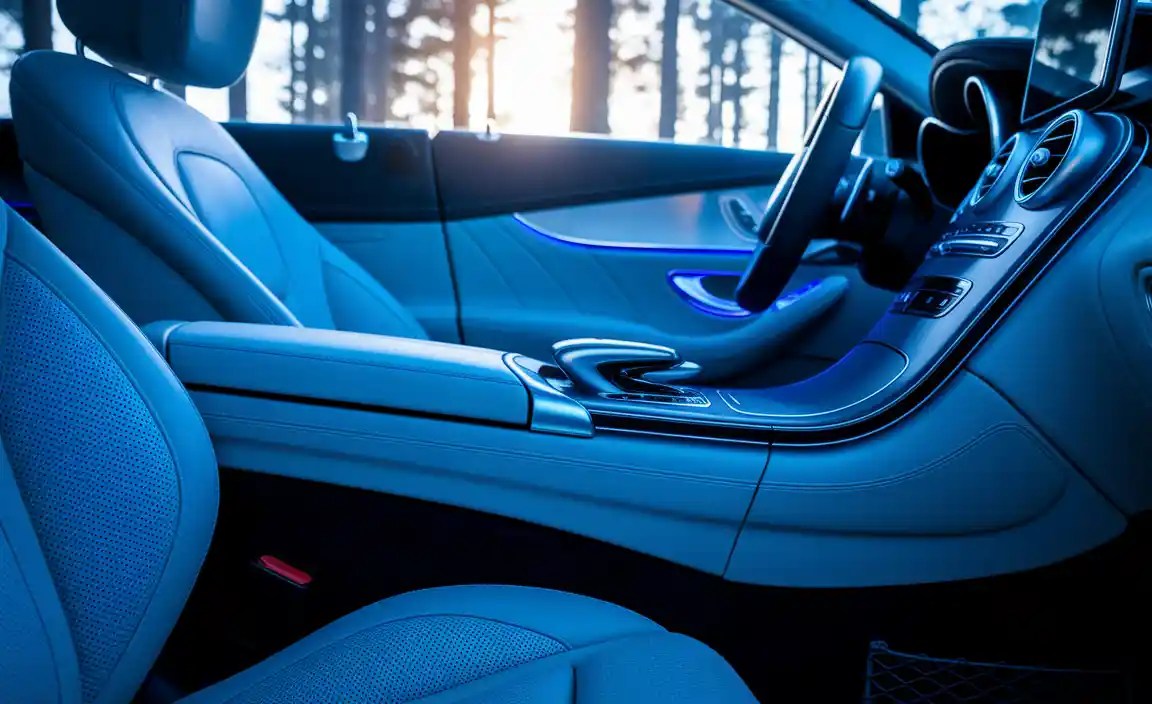Mercedes-Benz C Class Cabin Noise: Ultimate Driving Bliss
If you’re experiencing unwanted noise in your Mercedes-Benz C-Class, understanding the sources and solutions is key to restoring that signature quiet, luxurious driving experience. This guide covers common causes from road noise to engine sounds, offering practical, beginner-friendly ways to achieve ultimate driving bliss.
The serene cabin of a Mercedes-Benz C-Class is a hallmark of its luxury status. Yet, sometimes, unwanted sounds can intrude, breaking that peaceful sanctuary. Whether it’s the hum of the tires, a subtle rattle, or the murmur of the engine reaching your ears, persistent noise can diminish the joy of driving. Don’t worry, this is a common concern, and often, it’s quite manageable.
We’ll systematically uncover the culprits behind C-Class cabin noise and guide you through the steps to get back to blissful silence behind the wheel. From simple checks to more involved solutions, we’ll empower you to understand and address these auditory annoyances.

Understanding C Class Cabin Noise: What’s Making That Sound?
When you chose a Mercedes-Benz C-Class, you likely envisioned smooth, quiet journeys. Cabin noise can stem from various sources, and pinpointing the origin is the first step to a solution. Think of it like a detective case for your car.

Is the sound constant, or does it appear under specific conditions like acceleration, braking, or turning? Does it change with speed? Answering these questions will help narrow down the possibilities.
Common perpetrators of cabin noise include:
- Tire Noise: This is often the most frequent culprit. The interaction of your tires with the road surface can create a droning or humming sound.
- Wind Noise: Air moving around the car, especially at higher speeds, can generate whistling or rushing sounds.
- Engine and Powertrain Noise: While Mercedes-Benz excels at isolating the cabin, some engine or transmission sounds can subtly transfer.
- Vibrations and Rattles: Loose trim pieces, panels, or components can vibrate against each other, creating annoying rattles.
- Suspension Noises: Worn suspension parts can sometimes transmit clunks or thuds into the cabin.
- Exhaust System Sounds: A leak or issue with the exhaust can cause a louder-than-usual engine noise or a distinctive drone.
Common Sources of C Class Cabin Noise and Beginner-Friendly Solutions
Let’s dive into the most common sources of noise and how you, as a C-Class owner or enthusiast, can approach them. We’ll start with the easiest checks and move towards more involved solutions.

1. Tire and Road Noise
Your tires are the primary contact point between your C-Class and the asphalt. The tread pattern, tire pressure, and wear can all significantly impact the noise level inside the cabin. Aggressive tread patterns, for instance, tend to be noisier than those designed for comfort.
What to Look and Listen For:
- A constant hum or drone that increases with speed.
- A thumping sound, which could indicate uneven tire wear.
- A high-pitched whine, sometimes related to front tires during turns.
Beginner Solutions:
- Check Tire Pressure: Incorrect tire pressure is a common cause of increased road noise. Always maintain the pressure recommended in your C-Class owner’s manual or on the sticker inside the driver’s door jamb. You can find a reliable guide on checking tire pressure from the National Highway Traffic Safety Administration (NHTSA).
- Inspect Tire Wear: Uneven wear patterns (like cupping or feathering) can create significant noise. If you notice this, your alignment or suspension might need attention.
- Consider Tire Replacement: If your tires are old, worn, or simply known for being noisy, replacing them with a quieter, more comfort-oriented model can make a dramatic difference. Research tires specifically designed for luxury sedans that prioritize low noise, vibration, and harshness (NVH) characteristics.
2. Wind Noise
Wind noise is generated when air flows over and around your C-Class. This can happen through compromised seals, open windows, or even aerodynamic imperfections.
What to Look and Listen For:
- A whistling sound, especially at highway speeds.
- A whooshing or rushing sound as if a window isn’t fully closed.
- Noticeable drafts of air when driving.
Beginner Solutions:
- Inspect Weather Stripping: The rubber seals around your doors, windows, and sunroof are crucial for keeping noise out. Check them for cracks, tears, or stiffness. If they look worn, they might be allowing air to seep in. Gently clean them with a damp cloth and a mild soap, and consider applying a rubber protectant.
- Check Window and Sunroof Seals: Ensure your windows and sunroof are closing completely. Sometimes, a slight misalignment can cause a persistent leak. You can test this by spraying water on the seals while the car is stationary; if water gets inside, the seal isn’t working.
- Test for Air Leaks at Speed: On a calm day, drive at highway speeds and try to identify the general area where the wind noise is coming from. Sometimes, a simple adjustment or a slightly misaligned door might be the cause.
3. Engine and Powertrain Noise
Mercedes-Benz engineers go to great lengths to insulate the C-Class cabin from the engine and transmission. However, under aggressive acceleration or if there’s an issue, some noise might penetrate.
What to Look and Listen For:
- A deeper rumble or growl that increases with throttle input.
- A whine originating from under the hood.
- Clunking or jerking sounds during gear changes.
Beginner Solutions:
- Listen During Idle: With the engine running, stand outside the car and listen for any unusual noises. Then, sit inside with the engine at idle and doors closed. Does the noise persist? This helps differentiate between engine noise and other sources.
- Check Engine Mounts (Visual Inspection): While replacing engine mounts is a more advanced DIY task, you can visually inspect them for obvious signs of damage or leaks. Severely worn mounts can transmit more engine vibration and noise into the chassis. Consulting a professional for this is advisable if you’re unsure.
- Fluid Levels: Ensure all powertrain fluids (engine oil, transmission fluid) are at the correct levels. Low fluid can sometimes cause components to make more noise. Refer to your owner’s manual for proper checking procedures.
4. Rattles and Vibrations
These can be the most irritating noises because they often seem to come from everywhere and nowhere at once. They are typically caused by loose components or trim panels.
What to Look and Listen For:
- A high-pitched rattle or buzz that occurs over certain road surfaces or at specific RPMs.
- A creak or groan from the dashboard, door panels, or seats.
- Loose items in the car (glove box, door pockets) rattling.
Beginner Solutions:
- Remove Loose Items: Before assuming a car problem, empty your glove box, door pockets, and center console. Sometimes the simplest rattle comes from your sunglasses or a stray coin.
- Check Interior Trim Panels: Gently press on different parts of your dashboard, door panels, and center console while stationary. If you can pinpoint a squeak or rattle, try to identify if a specific panel area is loose. You might be able to gently push it back into place.
- Identify Source by Sound: When the rattle occurs, try to identify its general location. Is it the dashboard, a door, the rear deck, or under the seat? Sometimes placing a finger lightly on different surfaces can stop the rattle, helping to isolate the offending part.
- Secure Seatbelts: Ensure seatbelts are properly stowed and not banging against interior panels.
5. Suspension Noises
While often more pronounced over bumps, suspension noises can sometimes transmit into the cabin as clunks, creaks, or even thuds.
What to Look and Listen For:
- A clunking noise when going over bumps or turning.
- A creaking sound when the car is moving slowly.
- A “thud” over larger imperfections in the road.
Beginner Solutions:
- Pay Attention to Bumps: Note when the noises occur most frequently. Is it sharp impacts (potholes, speed bumps) or more constant flexing?
- Ensure Ride Height is Normal: Visually inspect if the car is sitting at its normal ride height. While unlikely for a beginner to diagnose, a very noticeable sag could indicate a suspension issue.
- Professional Inspection Recommended: Suspension noises, while sometimes simple wear and tear, can also point to more critical issues. If you suspect suspension problems, it’s best to have a qualified technician inspect it.
6. Exhaust System Noises
A compromised exhaust system, such as a leak or a loose component, can allow more engine sound into the cabin than intended.
What to Look and Listen For:
- A louder, deeper exhaust note than usual.
- A rattling sound from the undercarriage.
- Changes in engine sound pitch or volume.
Beginner Solutions:
- Visual Inspection (Safely): With the engine OFF and cool, you can attempt a visual inspection of the exhaust system from underneath the car (if safe and you have adequate clearance). Look for obvious holes, rust breaks, or loose hangers. Never get under a car that is only supported by a jack. Use jack stands on a level surface.
- Listen for Leaks: During cold starts, you might hear a slightly louder rumble. If this rumble is excessive or accompanied by a ticking sound, it could indicate a leak near the engine manifold.
- Professional Diagnosis: Exhaust system issues often require professional attention due to access and potential for burns.
Advanced Solutions and Modifications for Noise Reduction
For those seeking to elevate their C-Class’s tranquility even further, or if the beginner solutions don’t fully address the noise, there are more advanced steps you can consider.

Sound Deadening and Insulation
Sound deadening involves adding materials to absorb and block noise from entering the cabin. This is often the most effective way to combat persistent road and wind noise.
Materials to Consider:
- Sound Deadening Mats: These butyl-rubber based, foil-covered mats are applied to metal surfaces (doors, floor, trunk) to reduce vibrations and resonant noises. A popular type is Dynamat.
- Closed-Cell Foam: This foam acts as a decoupler and sound absorber, often used in conjunction with deadening mats or as a barrier.
- Mass Loaded Vinyl (MLV): A dense, heavy vinyl designed to block airborne sound. It’s often used as a second layer over sound deadening and foam.
Areas to Focus On:
- Doors: Treating the inner and outer door skins can significantly reduce road and wind noise, and also improve the sound of your audio system.
- Floor Pan: This is a major area for road noise transmission. Applying deadening mats and MLV here can make a substantial difference.
- Firewall: While more labor-intensive, treating the firewall (the barrier between the engine bay and cabin) can block engine noise.
- Trunk: Reducing noise from the rear, especially tire noise, can be addressed by treating the trunk floor and wheel wells.
Professional Soundproofing Services
If you’re not comfortable with DIY installation of sound deadening materials, many professional automotive audio or customization shops offer soundproofing services. They have the expertise and tools to apply these materials effectively and efficiently.
Acoustic Window Films
Some specialized window films are designed not only for UV and heat rejection but also for acoustic dampening. These can help reduce wind noise as well as general road noise that penetrates the glass.
Troubleshooting Common Mercedes-Benz C Class Rattles
Rattles can be particularly elusive. Here’s a focused approach for tackling them in your C-Class:
1. Dashboard Rattles
Often caused by the dashboard “visor” or trim pieces. Try applying felt tape to edges of trim pieces that seem to rub against each other. Sometimes, pressure points can be relieved by slightly loosening surrounding screws (if accessible) and then retightening. For persistent rattles, consider checking the screws holding the instrument cluster or glove box assembly.
2. Door Panel Rattles
These can originate from loose clips, vibrating speaker grilles, or internal door components. Gently test the door panel by pressing on different areas when the noise occurs. You can use automotive trim removal tools to carefully pry off door panels and add felt or foam tape to any contacting surfaces. Ensure the door handle and window switch surrounds are secure.
3. Center Console Rattles
The center console often houses many components. Check for loose coin holders, USB ports, or storage compartment lids. Sometimes, the armrest mechanism itself can develop a squeak.
4. Seat Rattles
Less common, but possible. Check under the seats for any loose plastic trim or objects that may have fallen. Ensure seat rails are clean and lubricated if they stick or creak.
Tools That Can Help Identify Rattles:
- Stethoscope: An automotive stethoscope is invaluable for pinpointing the exact location of a noise when the engine is running or while the car is in motion.
- Trim Removal Tools: These plastic tools prevent scratching interior panels when you need to access clips or remove trim.
- Felt Tape / Automotive Foam: Essential for cushioning contacting surfaces.
- Small Screwdriver Set: For tightening any accessible screws.
Table: Common C Class Cabin Noises and Their Likely Causes

| Type of Noise | Likely Cause(s) | Beginner Troubleshooting Steps |
|---|---|---|
| Humming/Droning | Tire noise, road surface, wheel bearings (less likely for beginner) | Check tire pressure, inspect tire wear, rotate tires if applicable. |
| Whistling/Whooshing | Wind noise, door/window seals, sunroof seals, antenna. | Inspect weather stripping, ensure windows/sunroof are fully closed, check for obvious gaps. |
| Rattling/Buzzing | Loose interior trim, dashboard components, door panels, items in storage. | Remove loose items, gently press on trim panels to isolate, apply felt tape. |
| Clunking/Thudding | Suspension components (struts, bushings), control arms, exhausts (if loose). | Note when occurring (bumps, turns), visual inspection of accessible suspension parts, professional diagnosis recommended. |
| Engine Rumble/Growl | Engine vibration transmitted via mounts, exhaust leak, normal engine sound under load. | Listen at idle vs. driving, check fluid levels, professional inspection for mounts/exhaust. |
Maintaining Your C Class for a Quieter Drive
Regular maintenance plays a vital role in keeping your C-Class cabin serene. Neglecting certain aspects can lead to noises down the line.
Key Maintenance Points:
- Tire Rotation and Balancing: Perform regular tire rotations (typically every 5,000-7,500 miles) to ensure even wear. Balanced tires also contribute to a smoother, quieter ride.
- Fluid Checks: Regularly check and maintain engine oil, transmission fluid, and power steering fluid levels as per your owner’s manual.
- Suspension Inspection: Have your suspension components checked during routine services (especially if you notice any new noises or handling changes).
- Door Seal Care: Keep your weather stripping clean and lubricated. This prevents drying, cracking, and ensures a good seal. A product like Gyeon Q² Trimoxide or similar rubber protectants can help.
- Engine Air Filter: A clogged air filter can sometimes make the engine work harder and potentially sound less refined.
Frequently Asked Questions
Q1: What is the most common cause of noise in a Mercedes-Benz C Class cabin?
A1: The most common causes are usually tire noise and road noise, especially depending on your tires and the road surface. Wind noise and minor rattles from interior trim are also frequent culprits.
Q2: How can I easily check if my tire pressure is causing noise?
A2: Check your tire pressure when the tires are cold using a reliable gauge. Inflate or deflate them to the recommended PSI found on the sticker inside your driver’s door jamb or in your owner’s manual. Notice if the noise changes after correcting the pressure.






